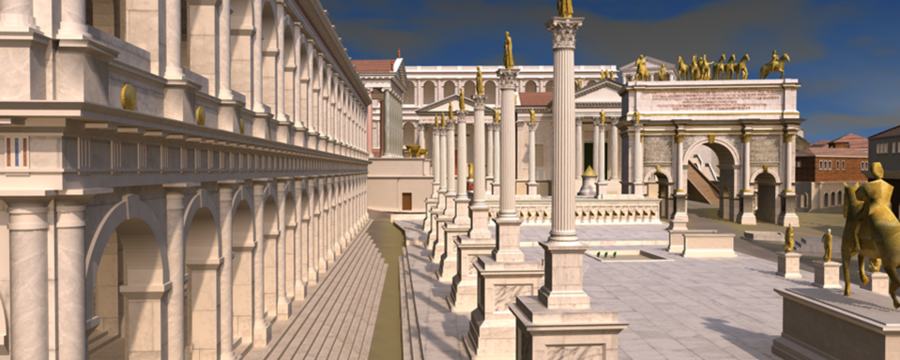Exploring Local Religion in Rome
Rome’s monumental temples inevitably attract much attention, not only due to their architectural grandeur, but also their central role in elite performative religion. Nevertheless, for the majority of the population living in the city’s neighbourhoods, religion played an equally important role, but in a different manner. For example, guardian spirits were venerated in peoples’ homes, and local communities were involved in celebrating specific plebeian festivals, which helped to integrate and involve the neighbourhoods within the wider religious practices of the city.
Originating in the sixth century BC, the Compitalia was a midwinter festival aimed at the lower classes. Rather than venerating major deities, the purpose of this festival was to honour the local protective spirits known as lares who were believed to reside at the crossroads. Small street shrines at these locations were used for the presentation of honey-cakes and other offerings by each family in the local community; the event also involved games and various other entertainment led by officials some of whom were slaves. By the later first century BC, one historian wrote of these slaves that:
During these [festival] days they take off every symbol of their servitude, so that by this act of humanity … they become better disposed to their masters and bear the sorrow of their fate less heavily.Dionysius of Halicarnassus, Roman Antiquities 4.14.2-4.
… guard all things with their eyes. They stand there for us, and preside over the city’s walls; they are present for us, and bring us help.Ovid, Fasti 5.134-6.
The shrines must have been familiar sights within the urban landscape, and hubs of festive activity on the day of the celebrations.
The inscriptions on the surviving shrines tell us something about how the cult of the Lares Augusti was organised. Rather than direct involvement by elite priests, the neighbourhoods were allowed to choose four officers (magistri vici) who, in addition to various local civic duties, were in charge of the festival, performed sacrifices and were responsible for the maintenance of the shrines. After the emperor’s death, these same local officials and the statues from the shrines were involved in the annual games held in his honour in October – an important step in the establishment of the emperor-worship.
The veneration of the emperor in neighbourhoods was just one aspect of local religion within the city. In peoples’ homes for example, numerous spirits relating to domestic life and the cult of the dead were recognised, and each household had its own guardian spirits, as did also each male and female citizen.
A relatively wealthy family home would typically contain a cabinet-like shrine known as a lararium to house the household gods, the Penates (often also referred to as spirits of the pantry), and the spirits of the ancestors (Lares). For well-preserved examples we can look outside Rome to Pompeii, where many survive. In the House of the Menander, for example, there is a prominent lararium in the central atrium or hallway, visible to any visitor or inhabitant entering the house. Reminiscent of a small temple, the shrine was decorated with painted plaster (stucco) and was comprised of a raised rectangular platform with a single column supporting a triangular roof. This small structure might have been used to house statuettes of the household gods, possibly accompanied by flowers, cakes, lamps and incense. Further within the house, the internal courtyard garden featured a small colourfully-painted niche set into the wall, complete with four small figurines that most likely represent the ancestors of the owners.
Although we don’t have this type of domestic evidence directly surviving in Rome, this particular style of residence (known as atrium or domus housing) featured within the city, depicted on the Severan marble plan. It’s a reasonable assumption that their wealthy owners would have had similar household shrines. In other cases, descriptions in the ancient sources can provide further insight into domestic practices relating to the veneration of family ancestors. For instance, an account of the prominent role of ancestor portraits in grand funerals. The display of these images within the home therefore served as an important means to remember and venerate the deceased; this is particularly important, for, in Rome, almost all tombs and burials were located outside the city. We know of a particular festival, the Parentalia, held each year in February during which people travelled out to the graves of their family members or patrons to present flowers and food, making a connection with the burial site.
Both the Compitalia and elements of domestic ritual activities therefore present us with useful insights into religion on a local, everyday level. The worship and veneration of guardian deities and reverence for the dead serves to highlight key aspects of Roman beliefs, which ultimately came to include the celebration of the divine spirit of the emperor. Furthermore, the involvement of the suburbs and lower classes shows that, together with the elite ritual sacrifices and major festivals that occurred within the heart of the city, Roman religion played a fundamental role in everyday life for the entire population.
Share this
Rome: A Virtual Tour of the Ancient City


Reach your personal and professional goals
Unlock access to hundreds of expert online courses and degrees from top universities and educators to gain accredited qualifications and professional CV-building certificates.
Join over 18 million learners to launch, switch or build upon your career, all at your own pace, across a wide range of topic areas.
Register to receive updates
-
Create an account to receive our newsletter, course recommendations and promotions.
Register for free







